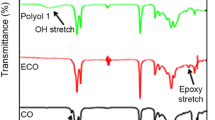Abstract
Two types of soy polyols have been prepared, one with secondary OH groups resulted from epoxidation of soybean oil followed by methanolysis (polyol type I) and the other with primary OH groups created from hydroformylation of soybean oil followed by hydrogenation (polyol type II). Cast polyurethane resins were prepared from these two types of polyols with Isonate 2143L, and rigid polyurethane foams were prepared from a blend of soy polyol and glycerol with PAPI 2901. Polyol II is much more reactive than polyol I towards polyurethane formation. This is evidenced from studies on polyurethane gel-times, glass transitions and rigid foam mechanical strengths. The reaction for the polyurethane formation is more complete for polyol II resulted from its higher reactivity than polyol I, although a less rigid polyurethane material is resulted from polyol II than from polyol I. Polyol type II also requires lower amounts of catalysts for rigid foam formulation. Both rigid foam systems produce foams having the required mechanical strength. The polyol II foam system behaves much like conventional rigid foam systems where the strength are proportional to system OH content, while the less reactive polyol I system does not.









Similar content being viewed by others
References
Saggese EJ, Scholnick F, Zubillaga M, Ault WC, Wrigley AN (1967) J Am Oil Chem Soc 44:43
Khoe TH, Otey FH, Frankel EN (1972) J Am Oil Chem Soc 49:615
Lyon CK, Garrett VH, Frankel EN (1974) J Am Oil Chem Soc 51:331
Hoefer, R, Gruber, B, Meffert, A, Gruetzmacher, R, US Patent 4,826,944
Chian KS, Gan LH (1998) J Appl Poly Sci 68:509
Petrovic, Z, Guo, A, Javni, I, US Patent 6,107,433
Frankel EN, Thomas FL (1972) J Am Oil Chem Soc 49:10
Frankel, EN, US Patent 3,787,459
Guo A, Javni I, Petrovic ZJ (2000) Appl Polym Sci 77:467
Guo A, Demydov D, Zhang W, Petrovic ZS (2002) J Polym Environ 10:49
Guo A, Cho Y-J, Petrovic ZS (2000) J Polym Sci, Part A: Polym Chem 38:3900
Petrovic ZS, Guo A, Zhang W (2000) J Polym Sci, Part A: Polym Chem 38:4062
Carey MA, Wellon SL, Elder DK (1984) J Cell Plast (1–2). Available at: http://www.polyurethane.org/standards/purmac_docs/article1.asp
Acknowledgements
We are indebted to The United Soybean Board for financial support. We also thank Riceland Foods, Goldschmidt, Air Products, Allied Signals, and Dow Chemicals for their generous donation of some chemicals.
Author information
Authors and Affiliations
Corresponding author
Rights and permissions
About this article
Cite this article
Guo, A., Zhang, W. & Petrovic, Z.S. Structure–property relationships in polyurethanes derived from soybean oil. J Mater Sci 41, 4914–4920 (2006). https://doi.org/10.1007/s10853-006-0310-6
Received:
Accepted:
Published:
Issue Date:
DOI: https://doi.org/10.1007/s10853-006-0310-6




